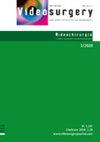脾床腹腔镜脾切除术加心包断流术治疗老年门静脉高压症
IF 1.6
4区 医学
Q2 SURGERY
引用次数: 0
摘要
相对于开放手术,腹腔镜脾切除术一直是首选,但关于腹腔镜脾切除术加心包断流术(LSPD)治疗老年患者的研究有限。目的评价脾床LSPD治疗老年门静脉高压症的安全性和远期疗效。材料与方法对132例高龄门静脉高压症患者(年龄50 ~ 60岁)进行手术治疗。将患者分为两组:脾切除术加心包断流术(OSPD)组。回顾性比较结果和结局。结果分析了两组患者的临床特点。患者的特征之间没有显著差异,临床资料显示他们的特征相似。两组手术时间差异无统计学意义(p < 0.05)。LSPD组出血量较少;早期开始口服;术后住院时间也较短(p < 0.05)。门静脉血栓的发生率;胰漏;胸腔积液;肺部感染;与OSPD组相比,LSPD组的伤口延迟愈合率也较低(p < 0.05)。在6-70个月的随访期间,两种方法的再出血发生率无显著差异;肝性脑病;生存率差异有统计学意义(p < 0.05)。结论脾床置换术是一种安全可行的治疗老年患者的方法。其临床效果优于OSPD。本文章由计算机程序翻译,如有差异,请以英文原文为准。
Spleen bed laparoscopic splenectomy plus pericardial devascularization for elderly patients with portal hypertension
Introduction Laparoscopy splenectomy has been a preferred choice over open surgery, but limited studies dealing with laparoscopy splenectomy plus pericardial devascularization (LSPD) for elderly patients are available. Aim To assess the safety and long-term efficacy of spleen bed LSPD for elderly patients with portal hypertension. Material and methods A total of 132 elderly patients (age > 60 years) suffering from portal hypertension were operated on in the department. The patients were divided into 2 groups: those undergoing LSPD, and those undergoing open splenectomy plus pericardial devascularization (OSPD). Results and outcomes were compared retrospectively. Results The clinical characteristics of the patients belonging to the two groups were studied. No significant difference between the characteristics of patients was reported and the clinical data revealed similarities in their characteristics. There was no significant difference in time taken for performing the operation (p > 0.05). The LSPD group showed less blood loss; started oral intake early; and the duration of post-operative hospital stay was also shorter (p < 0.05). Incidence rates of portal vein thrombosis; pancreatic leakage; pleural effusion; pulmonary infection; and delayed wound healing were also found to be lower in the LSPD group as compared to the OSPD group (p < 0.05). During a follow-up period of 6–70 months, no significant differences were found in the data for the two methods with respect to the incidence of rebleeding; hepatic encephalopathy; and survival (p > 0.05). Conclusions It was concluded that spleen bed LSPD is a safe and feasible procedure for treating elderly patients. It had a better clinical effect than that of OSPD.
求助全文
通过发布文献求助,成功后即可免费获取论文全文。
去求助
来源期刊
CiteScore
2.80
自引率
23.50%
发文量
48
审稿时长
12 weeks
期刊介绍:
Videosurgery and other miniinvasive techniques serves as a forum for exchange of multidisciplinary experiences in fields such as: surgery, gynaecology, urology, gastroenterology, neurosurgery, ENT surgery, cardiac surgery, anaesthesiology and radiology, as well as other branches of medicine dealing with miniinvasive techniques.

 求助内容:
求助内容: 应助结果提醒方式:
应助结果提醒方式:


